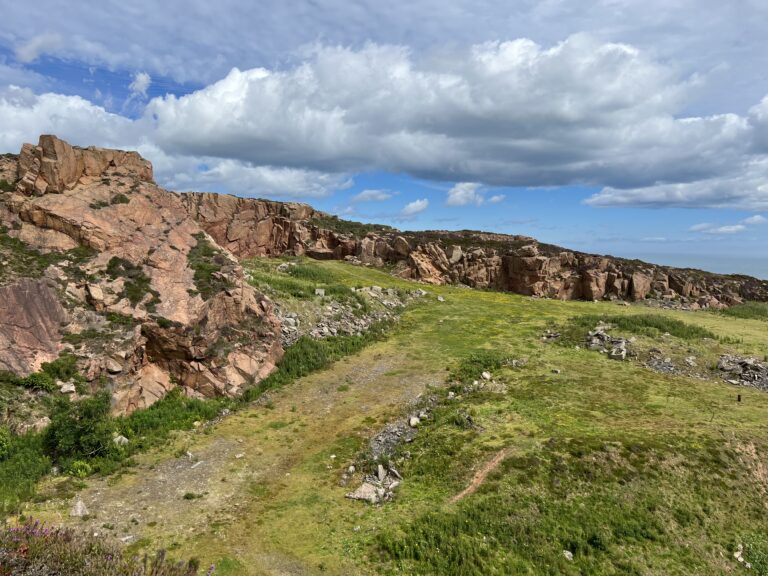Project Description
The Caledonide intrusions of Britain and Ireland remain largely underexplored, with significant potential for mineral enrichments in the shallow subsurface (Deady et al, 2023). The Quaternary glacial deposits covering many of these intrusions and the instability of mineral phases at surface make identifying and constraining mineralised regions difficult. Ongoing and historic exploration drilling for critical metals including nickel and copper in the Ordovician ‘Newer’ Basic Intrusions in northeast Scotland highlight the recognised potential for economic mineral deposits in the Caledonides. Regionally, the area is considered potentially prospective for critical minerals, including nickel, copper platinum group elements (PGEs) and lithium (Deady et al, 2023), though this requires further geochemical and geophysical investigations.
This project aims to combine inorganic geochemical analyses (ICP-MS, XRF, XRD), advanced petrography (SEM, LA-ICP-MS, Raman) and near-surface geophysical techniques, including electromagnetic induction and ground penetrating radar to identify and constrain critical mineral enrichments in the Caledonide instructions of the UK and Ireland. There is particular industry and governmental interest in the investigation of minerals needed for the production of low-carbon technologies (‘critical minerals’) (BEIS, 2022). These include nickel, copper and PGE enrichments in the ultrabasic intrusions in NE Scotland as well as lithium, tin and rare earth elements in granitic intrusions in the Scottish Grampians and the Newry and Leinster granites in Ireland. These investigations may include sampling and analyses of surface bedrock, drill core, glacial sediments and water samples to identify potentially mineralised regions. Performing localised near-surface geophysical surveys on sites of interest as well as utilising regional geophysical datasets will allow modelling and constraint of mineral deposit extent in the subsurface. These case study driven investigations will inform wider mineralisation models and result in better understanding of the crustal conditions which promote mineral enrichment in deep crustal settings (Armstrong et al, 2022)
Considering the breadth of the area concerned and the CASE partners involved, this project will focus primarily on the Caledonide intrusions in NE Scotland, specifically those in West Aberdeenshire. These will include the Arthrath, Insch, Huntly and Knock ultrabasic intrusions and occurrences of pegmatitic granite intrusions in the Cairngorms.
CANDIDATE BACKGROUND
Essential:
- BSc in an Earth Science related subject
- Demonstrated fieldwork experience
- Good verbal and written communication skills
- Ability to work independently and as part of a wider team
- Experience with using excel
Desirable:
- Extensive independent fieldwork experience
- Experience with large datasets
- Experience with computer coding languages eg. Python
Photo credit: Joseph Armstrong, University of Aberdeen
Supervisors
Primary Supervisor: |
University of Aberdeen, School of Geosciences / Geology & Geophysics Email: joseph.armstrong@abdn.ac.uk |
Ulrich OfterdingerSecondary Supervisor: | Profile: Ulrich Ofterdinger Email: U.Ofterdinger@qub.ac.uk Institution: Queen's University, Belfast Department/School: School of Natural and Built Environment |
Jean-Christophe ComteAdditional Supervisor: | Profile: Jean-Christophe Comte Email: jc.comte@abdn.ac.uk Institution: University of Aberdeen Department/School: School of Geosciences |
Additional Supervisor: | Professor John Parnell University of Aberdeen Email: j.parnell@abdn.ac.uk |
Amy GilliganAdditional Supervisor: | Profile: Amy Gilligan Email: amy.gilligan@abdn.ac.uk Institution: University of Aberdeen Department/School: School of Geosciences |
References
Deady et al, 2023. Potential for Critical Raw Material Prospectivity in the UK. BGS Decarbonisation and Resources Management Programme Commissioned Report CR/23/024.
Business, Energy and Industrial Strategy (BEIS), 2022. Resilience for the Future: The United Kingdom’s Critical Minerals Strategy, HM Government.BGS 2023.
Armstrong et al, 2022. Carbon in Mineralised Plutons. Geosciences. 12(5), 202.
QUADRAT Themes
- earth-systems
Partners
To be confirmed






















































